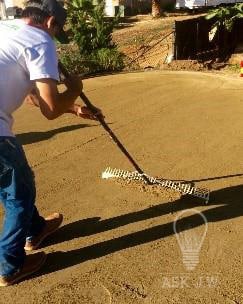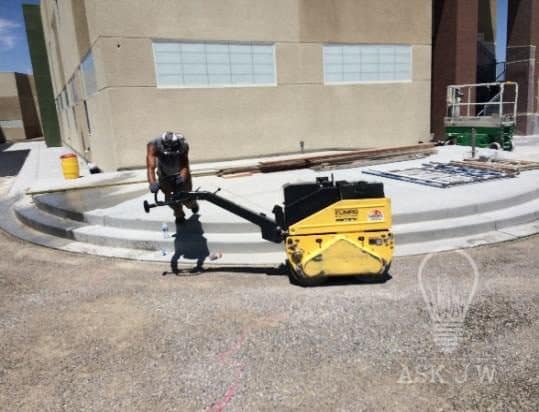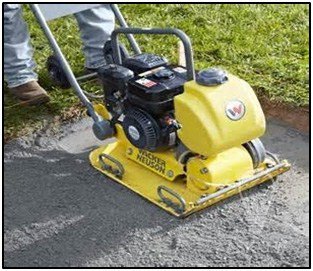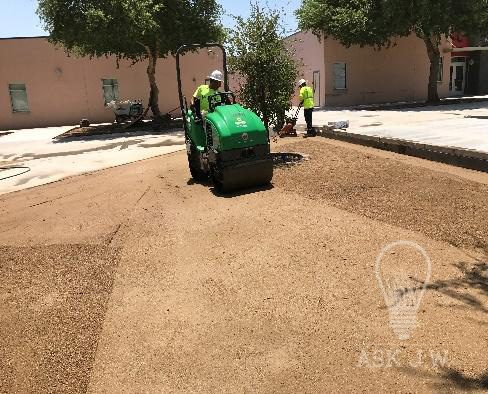During my visits with contractors across the country, I have noticed synthetic turf installations having depressed areas within them due to improper materials, poor compaction, bad repairs or irrigation problems. It is very important that grading materials that are placed under synthetic turf be of quality and can reach approximately 80 percent in compaction rate. Compaction is accomplished by vibrating, tamping and rolling the sub-base materials. This establishes a solid base in which to drive the nails while installing the turf. Compaction of subgrade materials is crucial to a successful installation. If the underlying materials are not compacted, the synthetic turf will settle due to foot traffic, water intrusion, wear and tear.
Most synthetic turf manufactures today give 8-10 year warranties… “Ask yourself… Will your subgrades integrity last that long”?
This month Ask JW will dive deep into the subject of “Compaction” and show you that ALL synthetic turf installations, whether it be very small or extremely large needs proper compaction.
“Your synthetic turf installation is only as good as your subgrade”… JW
Terms to Remember
Aggregates: Earthly Materials or structure formed from loosely compacted mass of fragments or particles.
Cohesion: The action or fact of forming a united whole. Unity, togetherness, solidarity, bond Physics; the sticking together particles of the same substance
Subgrade Soil Stability: the underlying soils being of quality, firm and steadfast
Grading Lifts: to move or bring upward from the ground or other support to a higher position
Saturate: Thoroughly soaked
Compaction: The process by which the porosity of a given form of sediment is decreased as a result of its mineral grains being squeezed together by the weight of overlying sediment or by mechanical means.
Compacting: Exert force on (something) to make it denser; compress, condense, pack down, tamp (down), flatten
Aggregates for Compaction
Below are types of materials that I DO NOT recommend using underneath synthetic turf. These materials will not retain cohesion or bond.
- Beach Sand
- Concrete & Mortar sand
- Top soil
- Silt
- Aggregate (rockbound)
- Loam
- Clay
- Caliche
I recommend aggregates that are created with high quality hard rock, sand and gravel. Below are types of materials for placing underneath synthetic turf. When placed in smaller lifts and compacted properly, these materials will retain density, allow permeability and withstand excessive water penetration.
- Crushed / Decomposed Granite
- Limestone Chat
- type II/ Road base
- 3/8” minus mixture
Washed aggregates without any fines will not sustain compaction. These aggregates may work great below your compacted materials as a drainage base for pet installations or areas of poor drainage. Placing washed aggregates with a mixture of fines below the synthetic turf will cause rock pockets, bumps, and sometimes make crunchy noise when walking on the surface of the turf.
Compaction Tools & Machinery
Plate compactor– This mechanical compactor is a must for all synthetic turf installations. You can rent mechanical compactors from most rental facilities.
Hand Tamper– A hand tamper is a compactor tool. This tool is used for all edges that a mechanical plate compactor cannot reach. It also is useful for compacting sidewalls of slopes and sand traps for putting greens.
Hand Tamper– A hand tamper is a compactor tool. This tool is used for all edges that a mechanical plate compactor cannot reach. It also is useful for compacting sidewalls of slopes and sand traps for putting greens.
Placement of Aggregates
During my travels I have noticed contractors not understanding how to properly place aggregates for compaction. I have witnessed installers placing 1 foot “lifts “of sub base materials, graded then placing a plate compactor on top thinking that would do the job of compacting 1 foot at a time.
The amounts that you import will depend on what type of machinery you are using to compact the materials. Highway builders with massive machinery only import 6-8 inches at a time. A standard walk behind vibratory plate compactor will only compact 2 inches at a time to gain approximately 80% compaction. 80% is the minimum allowance that I recommend for the surface of the synthetic turf to lay on. If you import more than 2 inches at a time you may sacrifice quality for production. If you are wanting to import 3-6 inches of imported aggregates at a time, then I recommend using a heavier plate compactor to achieve a dense finished surface that reaches 80% or more in compaction rate.
Water has an important role on compaction. Without knowing how much to saturate the imported materials, you may jeopardize the cohesion of layered compacted lifts.
Below is my recommendations of how you should import and compact aggregates below your synthetic turf.

Prior to importing sub base materials, remove any existing vegetation, rocks and debris. Smooth out existing soils. If you are using a Pre-Emergent, I recommend placing a layer below your imported materials and then after the compaction is complete. This will ensure the prevention of future re-growth of any vegetation that may want to sneak up through the drainage holes.


FIRST LIFT –Prior to placing the first lift, I recommend saturating the existing soils so that the imported materials will bond to the below subgrade.
Import approximately 2-3 inches of chosen aggregate materials and smooth out evenly.

After placing, leveling/smoothing the first lift, saturate the graded materials so that the water penetrates deep . DO NOT FLOOD!
I recommend you allow the soaked areas time to penetrate deep prior to compacting.

When a majority of the water has penetrated through the FIRST LIFT, compact the surface with a vibratory plate compactor going in different directions. Clean the bottom of the plate compactor frequently to avoid “Dragging”. Dragging is when the soils stick to the bottom of the plate compactor and slows the compactor down and leaves grooves in the compacted surface. This is very important when installing putting greens. Repeat this process including soaking each lift with water until you have reached your desired finish elevation.
If you are placing crushed drainage rock below your synthetic turf system, it is best to smooth and compact the crushed rock first and then place Decomposed Granite, Chat, or 3/8” minus as a cushion in LIFTS until you reach your desired elevation. Be careful when using equipment on top of the compacted crushed rock. Compacting the crushed rock only allows an even surface to place the DG, Chat or 3/8” minus on top and can easily be moved.
Repairs & Compaction
When adding irrigation or having to place utilities under pre-existing turf it is very important that when replacing the trench soils you must place back into the trench in lifts and compact thoroughly.
The above pictures show poor compaction at existing trenches, sprinkler heads, valve boxes, and an existing tree removal. This poor workmanship has now left depressions in the surface. These depressions no doubt will causes trip hazards and may cause injury.
Drains & Compaction

Exit drains, French drains and Catch Basins must have stable compaction surrounding its inlets. Excessive water run-off that flood near drain exits will cause failure in the subgrade and will prevent the drain from being serviceable.
Seams & Compaction
“Subgrade stability and its involvement to a successful seam…JW
If you are placing crushed drainage rock below your synthetic turf system, it is best to smooth and compact the crushed rock first and then place Decomposed Granite, Chat, or 3/8” minus as a cushion in LIFTS until you reach your desired elevation. Be careful when using equipment on top of the compacted crushed rock. Compacting the crushed rock only allows an even surface to place the DG, Chat or 3/8” minus on top and can easily be moved.

Common failures to seam ruptures are caused by underlying soils not being of quality, form and steadfast. Substandard subgrade materials that are unstable cause the underlying subgrade to expand and/or contract.
For Example: Soils that have extensive water intrusion, expansive properties, high in fines, low in aggregate, will cause instability. This may cause the seam to move and separate.
Playgrounds & Pet Facilities
Playground surfaces take a beating, especially synthetic turf. If the subgrade is not properly compacted it may cause premature wear in the synthetic turf backing. I recommend placing shock pad or a putting green surface at all heavy foot traffic areas to prevent depressions and trip hazards. Pet facilities require continuous maintenance which means water intrusion. If the sub surface is not compacted properly eventually there will be settling.
Exterior Edges

Exterior edges make or break the beauty of your installation. I have seen edges that have sank due to improper materials and poor compaction.
Turf Ribbons & Borders

When placing turf ribbons and borders it is crucial to compact the subbase to perfection. Most turf ribbons and borders receive water run-off and if not compacted properly will cause injury due to being a tripping hazard. If the area that is needing compacting is too small for a mechanical plate compactor, I recommend using a sledge hammer and large block of wood to ensure the surface is compacted to a minimum of 80%.
Putting Greens, Sand Traps, Bocce & Lawn Bowling

Putting Greens, Sand Traps, Bocce courts, and surfaces that rely on the performance of the surface, definitely needs complete attention. I recommend taking your time and ensure that you don’t over lift the materials causing soft spots in the surface.

Commercial Installations
Large Commercial installations require equipment that is large enough to handle serious compaction. Not only will larger equipment compact better but will speed up production rather than using a small plate compactor. If the commercial project requires *proctor testing (compaction readings), it is crucial to have an experienced grader that understands compaction readings and water ratio that is needed for a successful outcome.
* Proctor compaction test is a laboratory method of experimentally determining the optimal moisture content at which a given soil type will become most dense and achieve its maximum dry density
Grading Under Poor Weather Conditions

Whenever you are making the schedule to grade out your synthetic turf project, it is important to check the national weather forecast for any rain. If you get to the point that your project is all graded and a major storm comes passing through, not only will it disturb compaction rates, but you may have to remove and replace newly placed imported materials due to excessive water/flooding. 6 inches of flooded imported base may take days to dry out depending on the outside temperatures. A majority of imported materials that receive extensive amounts of water will cause separation between the aggregate and the fines and can no longer be used. I recommend synthetic turf contractors download the NOAA Weather Radar forecast App and stay informed on the weather.
For more information regarding aggregates and compaction please contact J.W. at askjw@sgwcorp.com or call Toll Free the Ask JW Hotline 888.846.3598
ACKNOWLEDGEMENTS: The American Heritage® Science Dictionary.
Other Topics:

About SGW
Learn more about SGW

Certifications
IPEMA, Lead-Free, and CAD Details

Warranties
Our Industry Leading Warranties

Ask an expert
See if we’ve answered your questions

Media
Our tried and true steps for installation

Blog
Learn about our turf in depth
Here to help
Our Commitment
We are committed to providing the best artificial turf products at competitive prices. Our warehouse carries the most advanced synthetic grass products available, engineered to look and feel like real grass. Every turf product is made with high quality materials that are safe for everyone, especially children and pets.

Industry Leaders
SGW Canada has always stood out among competitors, offering new products with the latest technology.

Service Oriented
The only thing better than our grass is our customer service. Our staff is committed to providing the best experience possible for our clients.

Quality Driven
At SGW Canada we only offer products that maintains a high standard of quality. Backed by up to a 15 year warranty, the best in the industry.







































